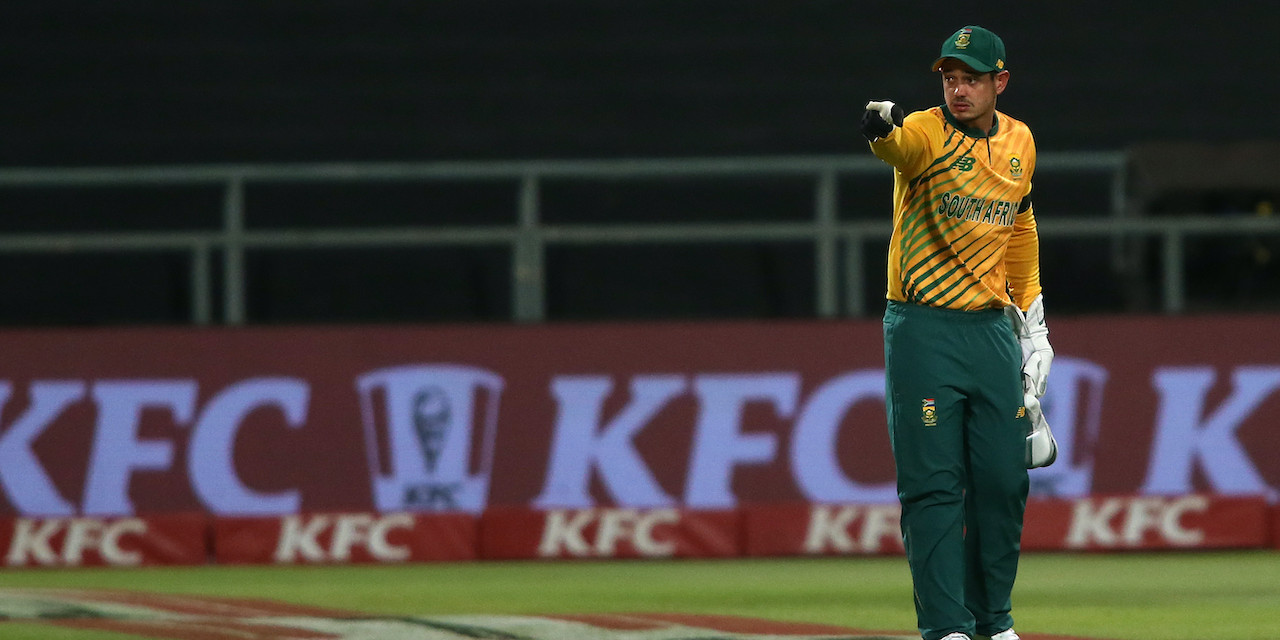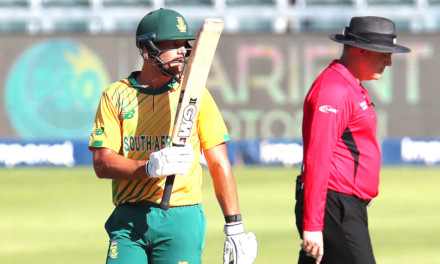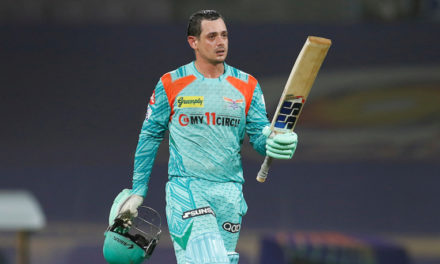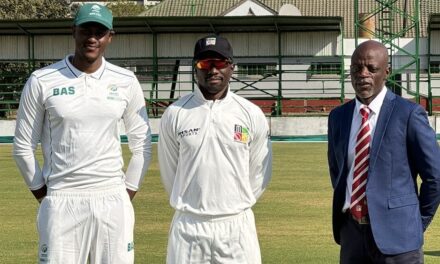The recently completed T20I series between the West Indies and South Africa was, in a nutshell, a set of games that contained all the ingredients to keep fans on the edges of their seats: a pretty even contest between bat and ball, several momentum shifts throughout, finally reaching a climactic end with a decider. The Proteas came out ahead 3-2, and this is their first series win in this format since 2019.
There are just a few more months to go before the T20 World Cup begins. And if we were to put it in more academic terms, this series was a priceless study guide before the exams. Despite the favourable result, there were multiple occasions that raised concerns. Whenever the top-order laid down a solid platform, the middle-order batters couldn’t take the initiative and finish the innings with a bang. In addition, each of South Africa’s successful games involved a stellar bowling effort to defend a decent score. But let’s dissect this overall performance and assess how each of the players fared.
Quinton de Kock – 255 runs @ 51, 3 half-centuries, best score of 70
Not only did he score the most runs in the Test series, but he absolutely bossed it in the T20Is as well. His return to form has been a telling boon for the Proteas. More importantly, he adeptly adjusted to the conditions, knew when to step on the gas, and when to calmly accumulate to keep the score moving along at a reasonable rate.
Reeza Hendricks – 78 runs @ 19.5, best score of 42
This was the perfect time for the stylish right-hander to push his case to make the second opener’s spot his own, but middling returns have yet again made the situation tougher. He played a handy knock in the second game, but that was a chance to convert the 42 into something more substantial. He got off to a quick start in the first and third games, but gave away his wicket when attempting to accelerate. There definitely are consistency issues to sort out.
Temba Bavuma – 76 runs @ 15.2, best score of 46
The skipper had a fruitful series in terms of team results. But when we factor in the individual results, this was a frustrating run of games. He looked reasonably fluent in the first two games, but in the next two games, two rather irresponsible shots were his undoing. Leadership comes with its challenges and high expectations, and right now it seems like he’s in the adjustment process of taking ownership of his roles. There’s still an ongoing debate as to whether he should open or come in at first drop, with the former being the more favoured option. On a more positive note, his bowling changes and field placement tactics proved to be instrumental later in the series.
Aiden Markram – 113 runs @ 37.66, 1 half-century, best of 70
Given his breakthrough home series against Pakistan, it was baffling to see that he wasn’t a confirmed starter in the XI right from the beginning of this series. Nevertheless, he managed to adjust to his slightly different role after a couple of unconverted promising starts. His game against spin has markedly improved, and his six-hitting ability has made him a very reliable top-order option in a relatively short space of time. He has definitely booked a spot in the World Cup squad.
Rassie van der Dussen – 97 runs @ 24.25, 1 half-century, best of 56*
There’s no doubt over his ability, but this series was definitive proof that #5 is way too low a batting position. He isn’t quite known to be a player who gets going right from the first ball, and often bides his time before opening up and clearing the boundaries. His half-century in the first game helped save face for the Proteas and set up a moderately competitive total. Aside from that knock, he struggled to accelerate towards the end of the innings and was exposed by quality death bowling from the likes of Obed McCoy and Dwayne Bravo. With a lot of top-order options in the mix, it’ll be hard to accommodate everyone, but that can be a discussion for a later date.
David Miller – 52 runs @ 13, best of 18*
Without question, this was by far one of his most forgettable T20I series. Though he’s well-known for his finishing abilities and brutal striking, the normally bruising left-hander had a severely lackluster outing. It felt like he had little to no answers to deliveries wider outside off, and often struggled for timing. At the same time, it would be too harsh to call for him to get dropped; over the years, he’s been a trusted batter for the Proteas in the middle order, and he should be backed to fire when it’s crucial.
Heinrich Klaasen – 17 runs @ 8.5, best of 10
The big hitter was another middle-order option who couldn’t come off, and after two poor games, wasn’t given a chance in the remainder of the series. Despite a rather respectable series against Pakistan, he couldn’t get it together in this series, and that might end up being quite costly. From captaining a second-string Proteas side to not being an incumbent in the strongest XI speaks volumes. His overall T20I strike rate is indicative of his calibre as an impact player, but with the tournament coming up in mere months, there won’t be too many chances to regain form.
George Linde – 9 runs @ 2.25, best of 6; 6 wickets @ 20.83, economy rate of 7.81
To keep it simple: a steady series with the ball, but a pretty disappointing series with the bat. Even though his left-arm spin is the stronger of his skills, he’s a genuine all-rounder. He performed his new-ball spinner role acceptably well, often taking a wicket in his first over and stifling the flow of runs early on. This series has also provided the assurance that he’s more than good enough to play as the second spinner alongside the frontline option in Tabraiz Shamsi. At the same time, he’ll want to work on maximizing his potential with the bat, especially since the Proteas are in dire need of a middle-order accelerator who can hit the high gear right from the beginning.
Wiaan Mulder – 9 runs, 2 wickets @ 15.5
It wasn’t until the very last game until we got to finally see a seam-bowling all-rounder get a chance to play. South Africa stuck to the six-batter approach until it became reasonably obvious that things weren’t going as planned. The youngster may not have been able to do much with the bat, but the latter half of his spell with the ball made a key difference. He dismissed the Windies skipper Kieron Pollard and Andre Russell in consecutive deliveries, and we’re all aware of their ominous reputation as fearsome strikers. While it’s too early to say that he’s a prospective death-bowling option, he’s done a handy job to take the pace off during the middle overs. He’s one for the future, and it’s not quite clear about whether he’s a certainty in the T20 World Cup plans, but he’s taken the initiative.
Kagiso Rabada – 7 wickets @ 24.28, economy rate of 9.44
Much was expected from the premier spearhead, and by his standards, this was quite an up-and-down sort of series – he impressed in patches, but had moments where things could’ve gone better. He bowled a tight final over under pressure in the third match but was at the receiving end of some lusty blows from Pollard and Allen in the very next game. Fortunately, he bounced back to devastating effect in the last game. He’s one of the best fast bowlers in the country, and even though bowling at the death is a difficult skill to master, he’ll hope to fine-tune his line and length going forward.
Anrich Nortje – 4 wickets @ 24.5, economy rate of 7
The Proteas pace ace has been fantastic over the course of the entire tour, and the most important takeaway from the T20I series is his death bowling. It’s been an ongoing unanswered question, and the highlight for him would surely have to be the third game. The Windies needed 19 from the last two overs, and with Nicholas Pooran and Fabian Allen still batting, one would’ve thought that it seemed rather straightforward. However, Nortje nailed his yorkers in the 19th over, and trapped Pooran on his penultimate ball. That over yielded just 4 runs, and eased the pressure for South Africa. Whenever he wasn’t taking wickets, he often startled the Windies batsmen with his sharp pace and change-ups.
Lungi Ngidi – 5 wickets @ 39.4, economy rate of 10.94
First of all, the T20 format has been rough for the usually consistent fast bowler. Up until the last game, he looked completely out of sorts, consistently bowling a hittable length at a hittable pace. Evin Lewis particularly enjoyed his bowling, scoring several boundaries. With other seam-bowling options available, it was quite puzzling to fathom how he ended up playing the entire series despite a couple of torrid games. Thankfully, he slightly turned things around when he took the wickets of Lewis and Hetmyer at key junctures. But then again, his overall performance has put the team in quite a quandary.
Tabraiz Shamsi – 7 wickets @ 11.42, economy rate of 4
He’s the top-ranked bowler in T20Is, and the way he went about during this series only further accentuated that. Compared to a couple of years ago, the left-arm wrist spinner has improved in leaps and bounds. He made the most of helpful surfaces and was regularly able to generate threatening amounts of turn in addition to his variations in line, length, and pace. The Windies batters were visibly more circumspect against his bowling, and a few were struggling to read his deliveries. He’s shown his capabilities as a very versatile bowler – when he wasn’t among the wickets, he masterfully stymied the scoring rate. There’s no question about his Man of the Series status, and it’ll be exciting to see how he goes in the UAE, come the World Cup.
Bjorn Fortuin
The Proteas opted for a spin trio in the decider, so that created an opening for the left-arm finger spinner. He ended up bowling just the first over of the chase, and that was it. However, if we look at the bigger picture, he’s been in and around the squad frequently in recent times. In addition to his bowling, he can bat down the order, too. With Linde stepping up well, he’s likely to remain a reinforcement spin choice at the moment.
The Gameless Players
Considering the fact that having a balanced XI was the crux of South Africa’s concerns, it’s time to discuss the players that couldn’t get an opportunity to play even one game.
Sisanda Magala has been touted as a potential solution as a death bowler, but later this series it came to light that he was nursing ankle discomfort and didn’t recover sufficiently.
Lizaad Williams was probably the unluckiest of the players that went gameless. He was the silver lining for the Proteas during the home series against Pakistan, since he had the best economy rate in what was a tough ordeal for all the SA seamers. He could’ve been given the final two games to see if he’d be a viable choice.
Left-armer Beuran Hendricks was another alternate option, but given his expensive returns against England and Pakistan, it was always going to be difficult for him to earn game time.
Since there were two futile attempts to get a top-order batter to be the makeshift sixth bowler, that problem could’ve been alleviated with the inclusion of an allrounder like Andile Phehlukwayo. He might be out of form, but the least he could do is provide some stability amid a top-heavy batting card.
As far as the batting is concerned, one can make a case for the inclusion of Janneman Malan at the top, since Reeza Hendricks underperformed. Similarly, Kyle Verreynne could have been handed an opportunity at the expense of David Miller in the final two games, but the experienced campaigners received the benefit of the doubt.
Parting Thoughts?
To round it off, there’s plenty to appreciate. The bowlers have delivered whenever the score after batting first seemed to be adequate or just a sliver above par. However, the bowling can’t always be winning you games.
This is an occasion to celebrate. It’s the first series win in this format as a whole. At the same time, the celebration can’t transcend the hunger to rectify the shortcomings and enhance the strong areas. There’s little to no room for error, and the priority will be performing at the level of intensity desired as well as a more clinical and prudently aggressive brand of cricket. And this is the concept that #ProteaFire revolves around.











